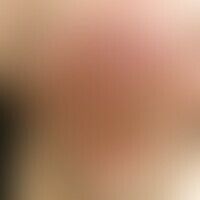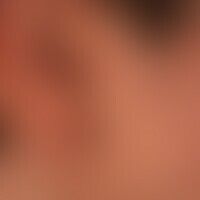Image diagnoses for "Plaque (raised surface > 1cm)", "Face"
111 results with 280 images
Results forPlaque (raised surface > 1cm)Face

Lupus erythematodes chronicus discoides L93.0
Lupus erythematodes chronicus discoides , chronic moderately indurated plaques, marginal with inflammatory activity, central scarring.
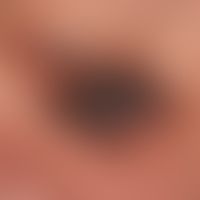
Lentigo maligna melanoma C43.L
Lentigo maligna melanoma: Plaque with nodular parts, known for years, first brown, then gradually black, asymmetric, multicoloured, bizarrely limited plaque with nodular parts; the histological diagnosis was made from the nodular part.
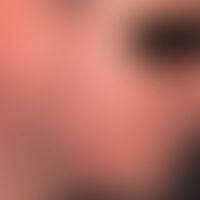
Acne conglobata L70.1
Acne conglobata: Condition following acne conglobata with scars and scar strands that have sunk in teisl, sometimes bulging and disfiguring.
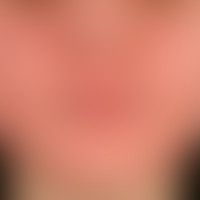
Psoriasis seborrhoic type L40.8
Psoriasis seborrhoeic type: for several months, symmetrical, only slightly elevated, homogeneously filled red-yellow, slightly accentuated, scaly plaques, which have remained in the same place for several months, with red lips.

Chronic actinic dermatitis (overview) L57.1
dermatitis chronic actinic: severe extensive, permanently itchy eczema reaction of the entire face with intensification of the eyelid regions. the changes were significantly improved in the winter months, but recur with low UV irradiation (going shopping). in the meantime, normal daylight must also be avoided.
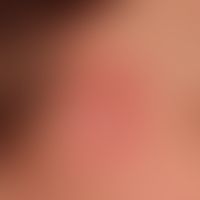
Lupus erythematodes chronicus discoides L93.0
Lupus erythematodes chronicus discoides: characteristic focus at the temple.

Airborne contact dermatitis L23.8
Airborne Contact Dermatitis: chronic (>6 weeks) extensive, enormously itchy and burning eczema with uniform infestation of the entire exposed facial area including the eyelids.

Ain D48.5
AIN: perianally localized, less sympotmatic, extensive, whitish erosive plaque at 3 o'clock; secondary findings anal fissure at 6 o'clock (actual cause of the doctor's visit)
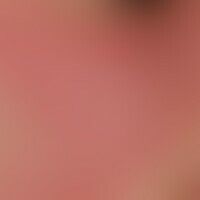
Lupus erythematosus systemic M32.9
Systemic lupus erythematosus: pronounced findings with bilateral, symmetrical, flat plaque formation; fine erosions and crustal formations; detailed view.
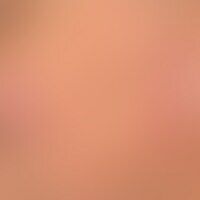
Lupus erythematodes chronicus discoides L93.0
Lupus erythematodes chronicus discoides: dry-scaling, red, hyperesthetic, plaques with adherent scaling that have existed on both halves of the face for 5 years; no evidence of systemic LE. DIF with typical pattern.

Lupus erythematodes chronicus discoides L93.0
Lupus erythematodes chronicus discoides: cutaneous chronic lupus erythematosus. years of course with circumscribed red scarring plaques (circle - with whitish atrophic area without follicular structure): arrow: dermal melanocytic nevus.

Melanosis neurocutanea Q03.8
Melanosis neurocutanea, detailed picture with multiple, sharply defined, pigmented, black spots and plaques.
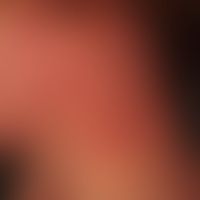
Epidermolysis bullosa junctionalis generalized intermediaries (non-herlitz) Q81.1
Epidermolysis bullosa dystrophica dominans: 35-year-old female patient, with extensive scarring blister formation after banal traumas (e.g. under plasters, or under pressure). First manifestation in the first months of life. recurrent formation of basal cell carcinomas.

Leprosy (overview) A30.9
Type I leprosy reaction "upgrading reaction": in a patient with Boderline lepromatous leprosy, characterized by an inflammatory flare-up of facial plaques.
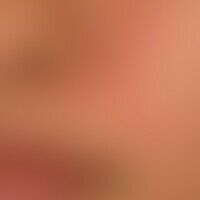
Seborrheic dermatitis of adults L21.9
Dermatitis, seborrheic: Blurred, delicately reddened, coarse lamellar scaling, flat, slightly infiltrated plaques in a 24-year-old female patient.

Tuberculosis cutis luposa A18.4
Tuberculosis cutis luposa: The 32-year-old Syrian has an irregularly limited, symptom-free, skin-coloured, sunken scar with marginal aggregated, painless, verrucous, brown plaques.
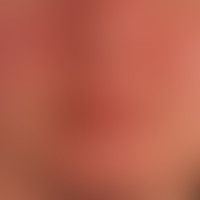
Mixed connective tissue disease M35.10
Mixed connective tissue disease: 43-year-old female patient (with clinical aspect of systemic lupus erythematosus) who fulfils the criteria of MCTD: U1.nRNP : titre : >1:1600; characteristics of systemic lupus erythematosus, Raynaud's phenomenon, swollen hands as well as feeling ill, fatigue, proximal muscle weakness (typical myositis symptoms).
